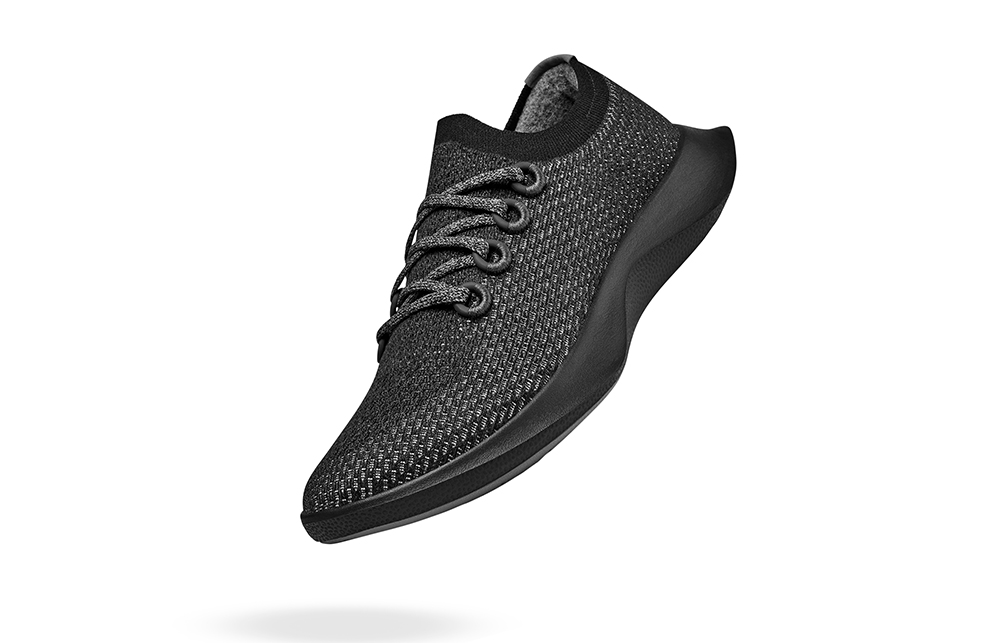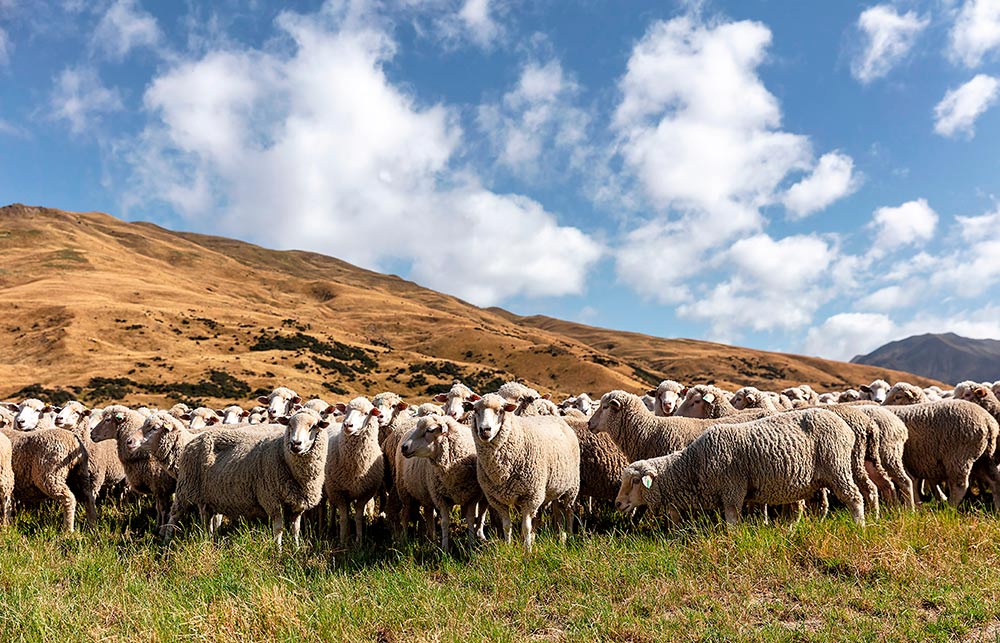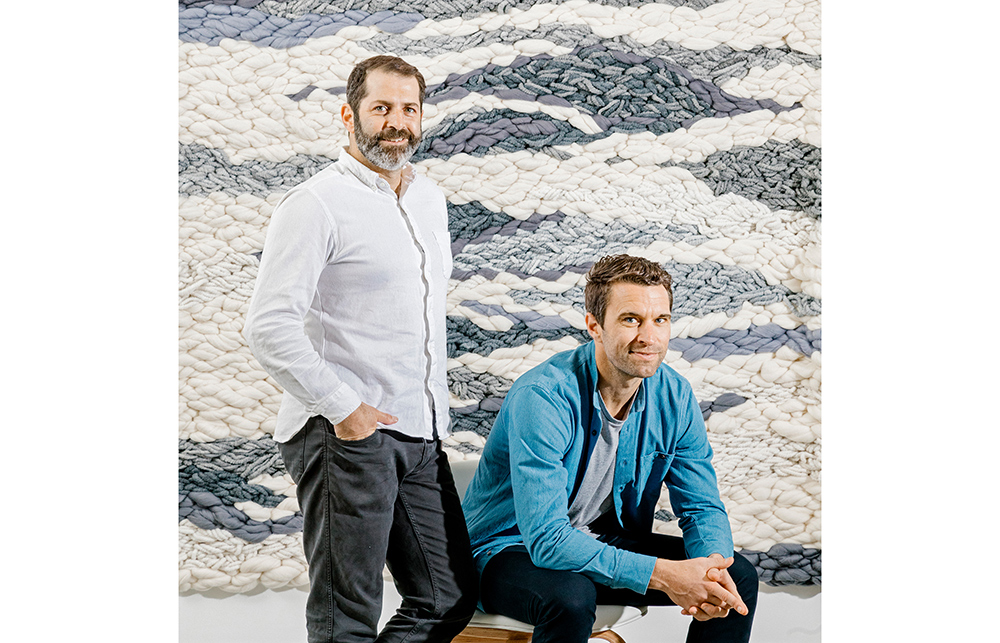
他們開(kāi)始尋找線蟲(chóng),這是一種能夠影響土壤營(yíng)養(yǎng)物質(zhì)循環(huán)的小蠕蟲(chóng),。他們選擇在新西蘭南島一座小山的陽(yáng)面草叢中開(kāi)挖,將土翻了出來(lái),,觀察土下面的生物,。對(duì)于一個(gè)外行來(lái)說(shuō),它看起來(lái)就像是泥土:棕色,、疏松,、臟乎乎的土壤。對(duì)于Allbirds(一家成立了6年的舊金山鞋履初創(chuàng)公司)的四名員工來(lái)說(shuō),,它似乎展現(xiàn)了一個(gè)機(jī)會(huì),,亦是土壤生命友好、環(huán)境友好的證據(jù)——打造Allbirds鞋履的各種材料在這一過(guò)程中不會(huì)對(duì)地球造成傷害,。
超過(guò)6000只粉色鼻頭的美利奴羊散布在2500英畝的流動(dòng)牧區(qū),,這些牧區(qū)是Glenaan Station農(nóng)場(chǎng)的一部分。這個(gè)有著百年歷史的農(nóng)場(chǎng)距離基督城北部?jī)尚r(shí)的車(chē)程,。這些動(dòng)物在其正常的生活過(guò)程中會(huì)向大氣釋放甲烷,,繼而鎖住熱量。然而,,借助這些小蠕蟲(chóng),,牧場(chǎng)土壤將在吸收二氧化碳的同時(shí)為生產(chǎn)羊毛的羊提供牧草,而這些羊毛將在遙遠(yuǎn)的地方成為時(shí)尚鞋履的裝飾材料,。
這一點(diǎn)對(duì)Allbirds來(lái)說(shuō)至關(guān)重要,,因?yàn)槠淦放菩蜗笳腔诠九c消費(fèi)者達(dá)成的環(huán)境友好合約。這家制鞋公司的可持續(xù)性負(fù)責(zé)人哈那?卡吉姆拉說(shuō):“有人譴責(zé)農(nóng)民向大氣排放碳和其他溫室氣體,,但這個(gè)農(nóng)場(chǎng)在碳減排方面做了大量的工作?!彼€說(shuō):“我們想確保自身眼光的長(zhǎng)遠(yuǎn)性,。這里不僅包括碳排放,還有被儲(chǔ)存的碳,?!?/p>

從一開(kāi)始,,Allbirds就利用了當(dāng)時(shí)出現(xiàn)的環(huán)境可持續(xù)發(fā)展趨勢(shì),并將其作為一個(gè)商業(yè)和營(yíng)銷(xiāo)賣(mài)點(diǎn),。公司并沒(méi)有使用對(duì)地球有害的塑料,,而是采用了天然材料制作鞋履。氣候改革者萊昂納多?迪卡普里奧非常喜歡Allbirds,,并投資了該公司,。Allbirds到目前為止籌集了7700萬(wàn)美元,。(機(jī)構(gòu)投資者包括重量級(jí)基金T. Rowe Price、富達(dá)和Tiger Global,,而這家私營(yíng)公司也在積極地籌集更多的資金,。)Allbirds標(biāo)志性的混合拖鞋是對(duì)“運(yùn)動(dòng)休閑”時(shí)尚運(yùn)動(dòng)突如其來(lái)的補(bǔ)充,它迅速地在喜歡休閑風(fēng)的職場(chǎng)人士中走紅,,由其是硅谷,。
Allbirds擁有21家零售店,其2019年銷(xiāo)售額預(yù)計(jì)為2億美元,,是目標(biāo)驅(qū)動(dòng)型企業(yè)群體中十分成熟的一員,,并引得其他制造商紛紛仿制其鞋履。Allbirds并沒(méi)有起訴模仿者,,也沒(méi)有為難他們,。去年,聯(lián)合創(chuàng)始人約瑟夫?茲威靈格發(fā)表了一封公開(kāi)信,,敦促競(jìng)爭(zhēng)者“剽竊我們實(shí)現(xiàn)可持續(xù)發(fā)展的方式”,,并表示將把Allbirds基于植物的鞋幫技術(shù)透露給所有詢(xún)問(wèn)的企業(yè)。公司稱(chēng),,截至1月,,20個(gè)品牌打算采用Allbirds的開(kāi)源技術(shù)來(lái)制作產(chǎn)品。
確實(shí),,對(duì)地球的友善是Allbirds最大的賣(mài)點(diǎn),。4月,公司在所有銷(xiāo)售的產(chǎn)品上打上了碳印記標(biāo)識(shí),。公司稱(chēng)其制作羊毛運(yùn)動(dòng)鞋的碳使用量為7.1公斤,,而業(yè)界平均值為12.5公斤。與此同時(shí),,Allbirds通過(guò)發(fā)布Dasher鞋款進(jìn)軍“性能”跑鞋領(lǐng)域,。這款鞋的原材料為美利奴羊毛和其他可以兼做健康補(bǔ)品食譜的材料:桉樹(shù)、甘蔗和蓖麻子油,。
與耐克和現(xiàn)有的其他運(yùn)動(dòng)服飾企業(yè)競(jìng)爭(zhēng)是一項(xiàng)艱巨的任務(wù),,由其是考慮到它是一款幾乎純天然的鞋履。Allbirds認(rèn)為,,堅(jiān)持其最大的優(yōu)勢(shì)——有益于地球的這個(gè)亮點(diǎn)——便是Allbirds其始終能夠處于不敗之地的絕佳機(jī)會(huì),。
可再生農(nóng)業(yè)可以追溯至圣經(jīng)誕生的時(shí)代,當(dāng)時(shí),,先人通過(guò)對(duì)其土地休耕來(lái)實(shí)現(xiàn)最基本的輪作,,以保持其土壤的肥力。然而,這個(gè)術(shù)語(yǔ)源于近代的媒體和營(yíng)銷(xiāo):雜志出版商鮑勃?羅戴爾在1989年曾經(jīng)談到了“再生”的優(yōu)點(diǎn),,它不僅僅只是可持續(xù)性,。
隨著氣候變化顧慮的出現(xiàn),再生農(nóng)業(yè)一直被譽(yù)為大氣碳捕捉的方式之一,。為Allbirds采購(gòu)羊毛的New Zealand Merino公司的首席執(zhí)行官約翰?布拉肯瑞奇說(shuō):“土壤是一個(gè)巨大的碳坑,。” 這意味著土壤能夠吸收碳,,避免其造成影響,。“如果方法得當(dāng),,它可以成為全球變暖問(wèn)題的一個(gè)重要解決方案,。”
3月的一個(gè)早上,,我在向北行進(jìn)之前在基督城市中心與布拉肯瑞奇和Allbirds團(tuán)隊(duì)進(jìn)行了會(huì)面,。在農(nóng)場(chǎng)到訪期間,Allbirds在過(guò)去一周一直都在與包括北面(North Face)和運(yùn)動(dòng)裝品牌Icebreaker在內(nèi)的其他品牌碰面,,談?wù)摽稍偕r(nóng)業(yè),。會(huì)議的議程就是合作。Allbirds的創(chuàng)新與可持續(xù)性副總裁嘉德?芬克說(shuō):“如果我們孤軍作戰(zhàn)的話(huà)不會(huì)造成什么影響,?!庇腥嗽诎装迳蠈?xiě)下了提示(“我們?nèi)绾为?jiǎng)勵(lì)種植者?”“我們?nèi)绾蜗破鹨豁?xiàng)運(yùn)動(dòng),?”)以及箴言(“市場(chǎng)在行動(dòng)方面比政策更快”),。一個(gè)名為“碳與環(huán)保主張:如何講述這個(gè)故事”的海報(bào)上畫(huà)著一副卡通畫(huà),其中有一個(gè)嗡嗡響的智能手機(jī)和多個(gè)對(duì)話(huà)泡泡,,里面寫(xiě)著:“社會(huì)責(zé)任”,、“健康”、“可追溯性”,、“道德”,。大堂里擺放著一個(gè)美利奴羊毛沖浪板、一張美利奴羊毛床(放在一個(gè)模擬臥室中)以及一張美利奴羊毛瑜伽墊(下面鋪著美利奴羊毛地毯),。
與鞋履的制作一樣,Allbirds的成功秘訣便是將真誠(chéng)的環(huán)保主義與激進(jìn)的營(yíng)銷(xiāo)結(jié)合起來(lái),。Allbirds的另一位創(chuàng)始人提姆?布朗在今年晚些時(shí)候在Zoom上表示:“我們看到,,整個(gè)世界正在圍繞一個(gè)全球性的問(wèn)題開(kāi)展合作。這是一個(gè)沒(méi)有國(guó)界的問(wèn)題,。要應(yīng)對(duì)氣候和環(huán)境領(lǐng)域即將出現(xiàn)的下一個(gè)危機(jī)并沒(méi)有那么困難,。”

但人們是否有足夠的環(huán)保意識(shí)去購(gòu)買(mǎi)羊毛做的跑鞋而不是標(biāo)準(zhǔn)的耐克款式呢,?或者在一雙經(jīng)典的Allbirds上花費(fèi)95美元,而不是選購(gòu)亞馬遜上只要29.99美元,、幾乎有著相同外觀的款式呢,?事實(shí)上,有一部分人確實(shí)是這樣的,。市場(chǎng)研究公司NPD Group的體育行業(yè)高級(jí)顧問(wèn)馬特?鮑威爾說(shuō):“千禧一代告訴我們,,他們對(duì)于產(chǎn)品如何制造、在哪里制造,、是否符合道德規(guī)范十分關(guān)心,,而且他們?cè)敢饣ǜ嗟腻X(qián)去購(gòu)買(mǎi)符合上述要求的產(chǎn)品。在疫情之前,,消費(fèi)者希望選購(gòu)能夠表達(dá)其價(jià)值主張的品牌,。我認(rèn)為如今更是如此?!?/p>
疫情和隨之而來(lái)的居家隔離令的確迫使Allbirds去做出相應(yīng)調(diào)整,。公司關(guān)閉了其總部和大多數(shù)零售店面。茲威靈格說(shuō):“我們一直都保持著盈利狀態(tài),,但我們也籌集了一筆危機(jī)基金,。”幾乎所有的店面自那之后都重新開(kāi)業(yè)了,;公司設(shè)法保住了所有450名雇員,;而且Allbirds甚至退回了收到的一筆薪酬保護(hù)計(jì)劃貸款。茲威靈格說(shuō):“坦白地講,,盡管我們完全有資格獲得這筆貸款”,,但我們認(rèn)為,將這筆款項(xiàng)讓給那些在風(fēng)投資金方面沒(méi)有Allbirds豐厚的其他公司,,是公司的道德義務(wù),。
我們并不是在說(shuō)Allbirds不屑利用市場(chǎng)的這一危機(jī)時(shí)刻。公司如今正專(zhuān)注于其跑鞋Dasher,。有人懷疑公司是否可以成功地進(jìn)入這個(gè)由耐克等公司以及亞瑟士,、新百倫(New Balance)和布魯克斯(Brooks)等知名專(zhuān)業(yè)品牌主導(dǎo)的市場(chǎng)?!杜懿绞ソ?jīng)》雜志(Runner’s World)的高級(jí)評(píng)測(cè)主編杰夫?登蓋特說(shuō):“我真不知道為什么會(huì)有公司選擇在2020年進(jìn)軍跑鞋領(lǐng)域,。這是一個(gè)競(jìng)爭(zhēng)異常激烈的市場(chǎng)?!?/p>
再者,,日常的運(yùn)動(dòng)鞋市場(chǎng)在Allbirds誕生之前便已是如此,。公司稱(chēng),Dasher的推出創(chuàng)造了其史上第三高的單日銷(xiāo)售額,,而排名前兩位的單日最高銷(xiāo)售額則出現(xiàn)在假日季,。茲威靈格說(shuō):“在這個(gè)時(shí)候說(shuō)某家公司很幸運(yùn)會(huì)讓人感到很奇怪?!逼澩`格此前是一名生物科技工程師,,曾經(jīng)舉辦晚宴招待當(dāng)時(shí)還是專(zhuān)業(yè)足球運(yùn)動(dòng)員的布朗,布朗后來(lái)成為了公司的聯(lián)合創(chuàng)始人,?!暗俏覀冞€是幸運(yùn)的:跑步?jīng)]有被禁止?!盇llbirds一開(kāi)始只在線上銷(xiāo)售,,但如今其半數(shù)店面都在美國(guó)之外,包括成都,、阿姆斯特丹,、柏林、東京,。布朗說(shuō):“在我看來(lái),,整個(gè)世界在眼下比以往任何時(shí)候需更要這款獨(dú)特的產(chǎn)品?!?/p>
在新西蘭的Glenaan Station農(nóng)場(chǎng),,Allbirds相對(duì)于其他大牌的市場(chǎng)排名較為靠后,原因在于,,其老顧客允許羊毛供應(yīng)牧羊人向其農(nóng)場(chǎng)進(jìn)行大量的投資,。第四代農(nóng)場(chǎng)主保羅?恩索最近花費(fèi)了10多萬(wàn)美元來(lái)從經(jīng)過(guò)其牧場(chǎng)的冰川河節(jié)流出了一條“小溪”,來(lái)喂養(yǎng)牲畜,。我問(wèn)他這條小河流對(duì)其羊毛生產(chǎn)有什么好處,?恩索眨了眨眼,滿(mǎn)臉疑惑,。他說(shuō):“它最終會(huì)流向海洋,。對(duì)于生態(tài)系統(tǒng)來(lái)說(shuō),我們將其看作是生物多樣性資產(chǎn),,也是為了水的衛(wèi)生,。”
但即便在這個(gè)仙境般的丘陵地帶也存在現(xiàn)實(shí)主義者,。距離Glenaan Station農(nóng)場(chǎng)不遠(yuǎn)的地方就是Castle Hill Station農(nóng)場(chǎng),,由喬斯和凱瑟琳范?克朗德特持有,他們?cè)?984年從荷蘭移民新西蘭,。(“這里的空間更大。”凱瑟琳解釋道,。)來(lái)自于其3000頭美利奴羊的羊毛也流入了Allbirds,。不過(guò),凱瑟琳從來(lái)沒(méi)有穿過(guò)他們的鞋,。她問(wèn):“鞋舒服嗎,?我本可以從線上預(yù)訂,但我們這代人真的不大喜歡用網(wǎng)絡(luò),?!?/p>
喬斯看著該夫婦8000英畝的農(nóng)場(chǎng)時(shí)說(shuō):“美利奴羊毛自身也具有一定程度的廣告效應(yīng)。有一部分公眾有能力購(gòu)買(mǎi)這類(lèi)產(chǎn)品,,而且這類(lèi)人群希望了解產(chǎn)品的出處,。羊毛背后的故事與產(chǎn)品自身有著幾乎相同的價(jià)值?!?/p>
如果Allbirds想要在市場(chǎng)中勝出,,則需要讓消費(fèi)者相信這個(gè)故事,并保持言行一致,。(財(cái)富中文網(wǎng))
本文另一版本登載于《財(cái)富》雜志2020年10月刊,,標(biāo)題為《沒(méi)有印記的鞋履》。
譯者:馮豐
審校:夏林
他們開(kāi)始尋找線蟲(chóng),,這是一種能夠影響土壤營(yíng)養(yǎng)物質(zhì)循環(huán)的小蠕蟲(chóng),。他們選擇在新西蘭南島一座小山的陽(yáng)面草叢中開(kāi)挖,將土翻了出來(lái),,觀察土下面的生物,。對(duì)于一個(gè)外行來(lái)說(shuō),它看起來(lái)就像是泥土:棕色,、疏松,、臟乎乎的土壤。對(duì)于Allbirds(一家成立了6年的舊金山鞋履初創(chuàng)公司)的四名員工來(lái)說(shuō),,它似乎展現(xiàn)了一個(gè)機(jī)會(huì),,亦是土壤生命友好、環(huán)境友好的證據(jù)——打造Allbirds鞋履的各種材料在這一過(guò)程中不會(huì)對(duì)地球造成傷害,。
超過(guò)6000只粉色鼻頭的美利奴羊散布在2500英畝的流動(dòng)牧區(qū),,這些牧區(qū)是Glenaan Station農(nóng)場(chǎng)的一部分。這個(gè)有著百年歷史的農(nóng)場(chǎng)距離基督城北部?jī)尚r(shí)的車(chē)程,。這些動(dòng)物在其正常的生活過(guò)程中會(huì)向大氣釋放甲烷,,繼而鎖住熱量。然而,,借助這些小蠕蟲(chóng),,牧場(chǎng)土壤將在吸收二氧化碳的同時(shí)為生產(chǎn)羊毛的羊提供牧草,,而這些羊毛將在遙遠(yuǎn)的地方成為時(shí)尚鞋履的裝飾材料。
這一點(diǎn)對(duì)Allbirds來(lái)說(shuō)至關(guān)重要,,因?yàn)槠淦放菩蜗笳腔诠九c消費(fèi)者達(dá)成的環(huán)境友好合約,。這家制鞋公司的可持續(xù)性負(fù)責(zé)人哈那?卡吉姆拉說(shuō):“有人譴責(zé)農(nóng)民向大氣排放碳和其他溫室氣體,但這個(gè)農(nóng)場(chǎng)在碳減排方面做了大量的工作,?!彼€說(shuō):“我們想確保自身眼光的長(zhǎng)遠(yuǎn)性。這里不僅包括碳排放,,還有被儲(chǔ)存的碳,。”
從一開(kāi)始,,Allbirds就利用了當(dāng)時(shí)出現(xiàn)的環(huán)境可持續(xù)發(fā)展趨勢(shì),,并將其作為一個(gè)商業(yè)和營(yíng)銷(xiāo)賣(mài)點(diǎn)。公司并沒(méi)有使用對(duì)地球有害的塑料,,而是采用了天然材料制作鞋履,。氣候改革者萊昂納多?迪卡普里奧非常喜歡Allbirds,并投資了該公司,。Allbirds到目前為止籌集了7700萬(wàn)美元,。(機(jī)構(gòu)投資者包括重量級(jí)基金T. Rowe Price、富達(dá)和Tiger Global,,而這家私營(yíng)公司也在積極地籌集更多的資金,。)Allbirds標(biāo)志性的混合拖鞋是對(duì)“運(yùn)動(dòng)休閑”時(shí)尚運(yùn)動(dòng)突如其來(lái)的補(bǔ)充,它迅速地在喜歡休閑風(fēng)的職場(chǎng)人士中走紅,,由其是硅谷,。
Allbirds擁有21家零售店,其2019年銷(xiāo)售額預(yù)計(jì)為2億美元,,是目標(biāo)驅(qū)動(dòng)型企業(yè)群體中十分成熟的一員,,并引得其他制造商紛紛仿制其鞋履。Allbirds并沒(méi)有起訴模仿者,,也沒(méi)有為難他們,。去年,聯(lián)合創(chuàng)始人約瑟夫?茲威靈格發(fā)表了一封公開(kāi)信,,敦促競(jìng)爭(zhēng)者“剽竊我們實(shí)現(xiàn)可持續(xù)發(fā)展的方式”,,并表示將把Allbirds基于植物的鞋幫技術(shù)透露給所有詢(xún)問(wèn)的企業(yè)。公司稱(chēng),,截至1月,,20個(gè)品牌打算采用Allbirds的開(kāi)源技術(shù)來(lái)制作產(chǎn)品。
確實(shí),,對(duì)地球的友善是Allbirds最大的賣(mài)點(diǎn),。4月,,公司在所有銷(xiāo)售的產(chǎn)品上打上了碳印記標(biāo)識(shí)。公司稱(chēng)其制作羊毛運(yùn)動(dòng)鞋的碳使用量為7.1公斤,,而業(yè)界平均值為12.5公斤,。與此同時(shí),Allbirds通過(guò)發(fā)布Dasher鞋款進(jìn)軍“性能”跑鞋領(lǐng)域,。這款鞋的原材料為美利奴羊毛和其他可以兼做健康補(bǔ)品食譜的材料:桉樹(shù)、甘蔗和蓖麻子油,。
與耐克和現(xiàn)有的其他運(yùn)動(dòng)服飾企業(yè)競(jìng)爭(zhēng)是一項(xiàng)艱巨的任務(wù),,由其是考慮到它是一款幾乎純天然的鞋履。Allbirds認(rèn)為,,堅(jiān)持其最大的優(yōu)勢(shì)——有益于地球的這個(gè)亮點(diǎn)——便是Allbirds其始終能夠處于不敗之地的絕佳機(jī)會(huì),。
可再生農(nóng)業(yè)可以追溯至圣經(jīng)誕生的時(shí)代,當(dāng)時(shí),,先人通過(guò)對(duì)其土地休耕來(lái)實(shí)現(xiàn)最基本的輪作,,以保持其土壤的肥力。然而,,這個(gè)術(shù)語(yǔ)源于近代的媒體和營(yíng)銷(xiāo):雜志出版商鮑勃?羅戴爾在1989年曾經(jīng)談到了“再生”的優(yōu)點(diǎn),,它不僅僅只是可持續(xù)性。
隨著氣候變化顧慮的出現(xiàn),,再生農(nóng)業(yè)一直被譽(yù)為大氣碳捕捉的方式之一,。為Allbirds采購(gòu)羊毛的New Zealand Merino公司的首席執(zhí)行官約翰?布拉肯瑞奇說(shuō):“土壤是一個(gè)巨大的碳坑?!?這意味著土壤能夠吸收碳,,避免其造成影響?!叭绻椒ǖ卯?dāng),,它可以成為全球變暖問(wèn)題的一個(gè)重要解決方案?!?/p>
3月的一個(gè)早上,,我在向北行進(jìn)之前在基督城市中心與布拉肯瑞奇和Allbirds團(tuán)隊(duì)進(jìn)行了會(huì)面。在農(nóng)場(chǎng)到訪期間,,Allbirds在過(guò)去一周一直都在與包括北面(North Face)和運(yùn)動(dòng)裝品牌Icebreaker在內(nèi)的其他品牌碰面,,談?wù)摽稍偕r(nóng)業(yè)。會(huì)議的議程就是合作,。Allbirds的創(chuàng)新與可持續(xù)性副總裁嘉德?芬克說(shuō):“如果我們孤軍作戰(zhàn)的話(huà)不會(huì)造成什么影響,。”有人在白板上寫(xiě)下了提示(“我們?nèi)绾为?jiǎng)勵(lì)種植者,?”“我們?nèi)绾蜗破鹨豁?xiàng)運(yùn)動(dòng),?”)以及箴言(“市場(chǎng)在行動(dòng)方面比政策更快”),。一個(gè)名為“碳與環(huán)保主張:如何講述這個(gè)故事”的海報(bào)上畫(huà)著一副卡通畫(huà),其中有一個(gè)嗡嗡響的智能手機(jī)和多個(gè)對(duì)話(huà)泡泡,,里面寫(xiě)著:“社會(huì)責(zé)任”,、“健康”、“可追溯性”,、“道德”,。大堂里擺放著一個(gè)美利奴羊毛沖浪板、一張美利奴羊毛床(放在一個(gè)模擬臥室中)以及一張美利奴羊毛瑜伽墊(下面鋪著美利奴羊毛地毯),。
與鞋履的制作一樣,,Allbirds的成功秘訣便是將真誠(chéng)的環(huán)保主義與激進(jìn)的營(yíng)銷(xiāo)結(jié)合起來(lái)。Allbirds的另一位創(chuàng)始人提姆?布朗在今年晚些時(shí)候在Zoom上表示:“我們看到,,整個(gè)世界正在圍繞一個(gè)全球性的問(wèn)題開(kāi)展合作,。這是一個(gè)沒(méi)有國(guó)界的問(wèn)題。要應(yīng)對(duì)氣候和環(huán)境領(lǐng)域即將出現(xiàn)的下一個(gè)危機(jī)并沒(méi)有那么困難,?!?/p>
但人們是否有足夠的環(huán)保意識(shí)去購(gòu)買(mǎi)羊毛做的跑鞋而不是標(biāo)準(zhǔn)的耐克款式呢?或者在一雙經(jīng)典的Allbirds上花費(fèi)95美元,,而不是選購(gòu)亞馬遜上只要29.99美元,、幾乎有著相同外觀的款式呢?事實(shí)上,,有一部分人確實(shí)是這樣的,。市場(chǎng)研究公司NPD Group的體育行業(yè)高級(jí)顧問(wèn)馬特?鮑威爾說(shuō):“千禧一代告訴我們,他們對(duì)于產(chǎn)品如何制造,、在哪里制造,、是否符合道德規(guī)范十分關(guān)心,而且他們?cè)敢饣ǜ嗟腻X(qián)去購(gòu)買(mǎi)符合上述要求的產(chǎn)品,。在疫情之前,,消費(fèi)者希望選購(gòu)能夠表達(dá)其價(jià)值主張的品牌。我認(rèn)為如今更是如此,?!?/p>
疫情和隨之而來(lái)的居家隔離令的確迫使Allbirds去做出相應(yīng)調(diào)整。公司關(guān)閉了其總部和大多數(shù)零售店面,。茲威靈格說(shuō):“我們一直都保持著盈利狀態(tài),,但我們也籌集了一筆危機(jī)基金?!睅缀跛械牡昝孀阅侵蠖贾匦麻_(kāi)業(yè)了,;公司設(shè)法保住了所有450名雇員;而且Allbirds甚至退回了收到的一筆薪酬保護(hù)計(jì)劃貸款。茲威靈格說(shuō):“坦白地講,,盡管我們完全有資格獲得這筆貸款”,,但我們認(rèn)為,將這筆款項(xiàng)讓給那些在風(fēng)投資金方面沒(méi)有Allbirds豐厚的其他公司,,是公司的道德義務(wù),。
我們并不是在說(shuō)Allbirds不屑利用市場(chǎng)的這一危機(jī)時(shí)刻。公司如今正專(zhuān)注于其跑鞋Dasher,。有人懷疑公司是否可以成功地進(jìn)入這個(gè)由耐克等公司以及亞瑟士,、新百倫(New Balance)和布魯克斯(Brooks)等知名專(zhuān)業(yè)品牌主導(dǎo)的市場(chǎng)?!杜懿绞ソ?jīng)》雜志(Runner’s World)的高級(jí)評(píng)測(cè)主編杰夫?登蓋特說(shuō):“我真不知道為什么會(huì)有公司選擇在2020年進(jìn)軍跑鞋領(lǐng)域,。這是一個(gè)競(jìng)爭(zhēng)異常激烈的市場(chǎng)?!?/p>
再者,日常的運(yùn)動(dòng)鞋市場(chǎng)在Allbirds誕生之前便已是如此,。公司稱(chēng),,Dasher的推出創(chuàng)造了其史上第三高的單日銷(xiāo)售額,而排名前兩位的單日最高銷(xiāo)售額則出現(xiàn)在假日季,。茲威靈格說(shuō):“在這個(gè)時(shí)候說(shuō)某家公司很幸運(yùn)會(huì)讓人感到很奇怪,。”茲威靈格此前是一名生物科技工程師,,曾經(jīng)舉辦晚宴招待當(dāng)時(shí)還是專(zhuān)業(yè)足球運(yùn)動(dòng)員的布朗,,布朗后來(lái)成為了公司的聯(lián)合創(chuàng)始人?!暗俏覀冞€是幸運(yùn)的:跑步?jīng)]有被禁止,。”Allbirds一開(kāi)始只在線上銷(xiāo)售,,但如今其半數(shù)店面都在美國(guó)之外,,包括成都、阿姆斯特丹,、柏林,、東京。布朗說(shuō):“在我看來(lái),,整個(gè)世界在眼下比以往任何時(shí)候需更要這款獨(dú)特的產(chǎn)品,。”
在新西蘭的Glenaan Station農(nóng)場(chǎng),,Allbirds相對(duì)于其他大牌的市場(chǎng)排名較為靠后,,原因在于,其老顧客允許羊毛供應(yīng)牧羊人向其農(nóng)場(chǎng)進(jìn)行大量的投資,。第四代農(nóng)場(chǎng)主保羅?恩索最近花費(fèi)了10多萬(wàn)美元來(lái)從經(jīng)過(guò)其牧場(chǎng)的冰川河節(jié)流出了一條“小溪”,,來(lái)喂養(yǎng)牲畜,。我問(wèn)他這條小河流對(duì)其羊毛生產(chǎn)有什么好處?恩索眨了眨眼,,滿(mǎn)臉疑惑,。他說(shuō):“它最終會(huì)流向海洋。對(duì)于生態(tài)系統(tǒng)來(lái)說(shuō),,我們將其看作是生物多樣性資產(chǎn),,也是為了水的衛(wèi)生?!?/p>
但即便在這個(gè)仙境般的丘陵地帶也存在現(xiàn)實(shí)主義者,。距離Glenaan Station農(nóng)場(chǎng)不遠(yuǎn)的地方就是Castle Hill Station農(nóng)場(chǎng),由喬斯和凱瑟琳范?克朗德特持有,,他們?cè)?984年從荷蘭移民新西蘭,。(“這里的空間更大?!眲P瑟琳解釋道,。)來(lái)自于其3000頭美利奴羊的羊毛也流入了Allbirds。不過(guò),,凱瑟琳從來(lái)沒(méi)有穿過(guò)他們的鞋,。她問(wèn):“鞋舒服嗎?我本可以從線上預(yù)訂,,但我們這代人真的不大喜歡用網(wǎng)絡(luò),。”
喬斯看著該夫婦8000英畝的農(nóng)場(chǎng)時(shí)說(shuō):“美利奴羊毛自身也具有一定程度的廣告效應(yīng),。有一部分公眾有能力購(gòu)買(mǎi)這類(lèi)產(chǎn)品,,而且這類(lèi)人群希望了解產(chǎn)品的出處。羊毛背后的故事與產(chǎn)品自身有著幾乎相同的價(jià)值,?!?/p>
如果Allbirds想要在市場(chǎng)中勝出,則需要讓消費(fèi)者相信這個(gè)故事,,并保持言行一致,。(財(cái)富中文網(wǎng))
本文另一版本登載于《財(cái)富》雜志2020年10月刊,標(biāo)題為《沒(méi)有印記的鞋履》,。
譯者:馮豐
審校:夏林
They came in search of nematodes, tiny worms that cycle nutrients through soil. They dug their hands into thatches of reedy grass on a sunny hillside on the South Island of New Zealand, turning over the earth, peering at what lived below. To an outsider, it looked like dirt: brown, crumbly, messy earth. To four employees of Allbirds, the six-year-old San Francisco footwear startup famous for its fuzzy woolen sneaker, it looked like an opportunity: life-affirming, environmentally pleasing proof that the materials that go into Allbirds shoes don’t hurt the planet in the process.
More than 6,000 pink-nosed merino sheep roam the 2,500 rolling acres that constitute Glenaan Station, a century-old farm two hours north of Christchurch. Through the normal course of being sheep, these animals spew methane into the atmosphere, trapping heat. Yet thanks to those small worms, the soil on this antipodean ranch sucks up carbon dioxide while growing grass to feed the sheep that produce the wool that adorn the feet of hipsters a world away.
This means everything to Allbirds, whose very identity is wrapped up in the eco-friendly compact it makes with its consumers. “Farmers get a bad rap for contributing carbon and other greenhouse gases to the atmosphere,” says Hana Kajimura, the sneaker company’s head of sustainability, who was visiting to check one of Allbirds’ sources of wool. “But this farm is doing so much to draw down carbon at the same time,” she adds. “We want to make sure that we’re looking at the whole picture. Not just what’s being emitted but also what’s being stored.”
From its start, Allbirds tapped into the then-emerging trend of environmental sustainability as a commercial and marketing attribute. Instead of planet-killing plastic, it made shoes with natural materials. Climate crusader Leonardo DiCaprio liked his Allbirds so much he invested in the company, which has raised more than $77 million to date. (Institutional investors include heavyweight funds T. Rowe Price, Fidelity, and Tiger Global, and the company, which is privately held, is actively raising more money.) The signature Allbirds hybrid slipper-shoe, an out-of-nowhere addition to the “athleisure” fashion movement, quickly caught on with casually clad professionals, particularly in Silicon Valley.
With 21 retail stores and 2019 sales estimated at $200 million, Allbirds is a full-fledged member of the purpose-driven corporate set. It has spawned a legion of copycat shoes, and rather than litigating, Allbirds makes life easy for imitators. Last year cofounder Joseph Zwillinger wrote an open letter urging rivals to “please steal our approach to sustainability” and offered to send the recipe for Allbirds’ plant-based soles to anyone who asked. As of January, 20 brands intended to release products made according to the Allbirds not-secret sauce, the company says.
Indeed, kindness to the planet is one of Allbirds’ biggest selling points. In April it slapped a carbon footprint label on everything it sells. It claims to use 7.1 kilograms of carbon to manufacture a wool sneaker, compared with an industry average of 12.5 kilograms. Around the same time, Allbirds jumped into the field for “performance” running shoes with the Dasher. It is made from merino wool and other materials that could double as the recipe for some kind of health tonic: eucalyptus, sugarcane, and castor bean oil.
It’s a tall order to go up against Nike and other athletic-apparel incumbents, especially with a nearly all-natural shoe. Allbirds figures that sticking with its best advantage—its good-for-the-planet sheen—represents its best chance of not getting left in the mud.
*****
Regenerative agriculture dates back at least to biblical times, when the ancients practiced rudimentary crop rotation by letting their fields lie fallow in order to keep the soil rich with nutrients. The term, however, has more recent roots in media and marketing: Magazine publisher Bob Rodale talked in 1989 about the virtues of “regeneration” as opposed to mere sustainability.
As climate change concerns have surged, regenerative agriculture has been touted as a way to sequester carbon from the atmosphere. “Soil is a huge carbon sink,” says John Brakenridge, CEO of New Zealand Merino, the agency that sources wool for Allbirds. This means that soil absorbs carbon, mitigating its impact. “Done right, this can be a big part of the solution to what we’re facing in global warming.”
One morning in March, I meet Brakenridge and the Allbirds team in downtown Christchurch, before heading up north. In between farm visits, Allbirds has spent the past week participating in a conference with other clothing brands, such as North Face and the activewear label Icebreaker, about regenerative agriculture. Collaboration is the order of the day. Says Jad Finck, Allbirds’ vice president of innovation and sustainability: “Nothing’s going to happen if we’re all siloed.” On a whiteboard, someone has written prompts (“How might we reward growers?” “How might we start a movement?”) and maxims (“The market can act faster than policy”). A poster titled “Carbon & Environmental Claims: How to Tell the Story” includes a cartoon of a buzzing smartphone and various words in speech bubbles: “social responsibility,” “wellness,” “traceability,” “ethical.” There’s a merino wool surfboard in the lobby, a merino wool bed in a mock bedroom, and a merino wool yoga mat on the merino wool carpeted floor.
This combination of earnest environmentalism and aggressive marketing is as much the Allbirds recipe as the makeup of its shoes. “You’ve seen the world coalesce around a global problem,” says Tim Brown, the other Allbirds founder, when we speak over Zoom later in the year. “It’s a problem that doesn’t know borders. It’s not too hard to draw a bow to the next crisis looming around the climate and the environment.”
But do people care enough about the environment to buy running shoes made of wool rather than a standard pair of Nikes? Or to spend $95 on a pair of classic Allbirds when Amazon sells a nearly identical-looking version for $29.99? In fact, a certain segment of people do. “Millennials tell us that they are very concerned about how products are made, where they’re made, whether they’re made ethically, and that they’re willing to pay more money for those that are,” says Matt Powell, a senior sports industry adviser at NPD Group, a market research firm. “Pre-COVID-19, the consumer wanted to align with brands that expressed their values. And I think that’s even more true now.”
The pandemic and subsequent stay-at-home orders did force Allbirds to adapt. It closed its headquarters and most of its retail stores. “We’ve always had a profitable business, but we amassed a rainy-day fund,” says Zwillinger. Nearly all the stores have since reopened; the company managed to avoid laying off any of its 450 employees; and Allbirds even returned a Paycheck Protection Program loan it had received. “Frankly, we were very eligible for it,” says Zwillinger, but notes the company nevertheless felt a moral obligation to free up funds for businesses less flush with venture money than Allbirds.
None of which is to say Allbirds is above capitalizing on a perilous moment in the marketplace. It is now focused on its running shoe, the Dasher. Skeptics doubt the company can successfully muscle into a market dominated by the likes of Nike and established specialty brands including Asics, New Balance, and Brooks. “I don’t know why anybody would get into the running shoe space in 2020,” says Jeff Dengate, senior test editor of Runner’s World magazine. “It’s a very competitive market.”
Then again, so was the everyday sneaker market before Allbirds came around. The company says the Dasher’s launch produced its third-best single-day sales ever, with the two better days having come in the holiday season. “It feels weird to say you’re lucky in a time like this,” says Zwillinger, a former biotech engineer who hosted a dinner for Brown, a former professional soccer player, and then became his cofounder. “But we kind of got lucky: Running’s not canceled.” Allbirds started by selling strictly online, but now about half its stores are outside the U.S., including in Chengdu, Amsterdam, Berlin, and Tokyo. Says Brown, “It felt like the world needed this particular product, more than ever, in this moment.”
*****
Back at Glenaan Station in New Zealand, Allbirds’ place in the market relative to more well known brands takes a back seat to the fact that its patronage allows the shepherd who supplies its wool to make impressive capital improvements to his farm. Paul Ensor, a fourth-generation rancher, recently spent more than $100,000 to fence off from grazing cattle a “wee stream” of the glacial river that runs along his acreage. I ask how the stream benefits his wool production. Ensor blinks at me, confused. “It just runs out to sea,” he says. “For the ecosystem. We look at it as an asset for biodiversity, for water health.”
But even in these fairy-tale rolling hills, there are realists. Not far from Glenaan Station is Castle Hill Station, a farm owned by Jos and Catherine Van de Klundert, who emigrated from the Netherlands to New Zealand in 1984. (“More space,” explains Catherine.) The wool from their 3,000 merino sheep also gets spun into Allbirds, though Catherine’s never put on a pair herself. “Are they comfortable?” she asks. “I could have ordered them online, but I’m from a generation that doesn’t really like to do that.”
“The thing about merino,” Jos says, looking out over the couple’s 8,000 acres, “is that it’s more or less marketing. There’s a certain part of the public that can afford it, and those sort of people want to know where the product is coming from. The story behind the wool has nearly the same value as the product itself.”
For Allbirds to win in the marketplace, it will need consumers to take that story and run with it.
A version of this article appears in the October 2020 issue of Fortune with the headline “A shoe with no footprint.”






